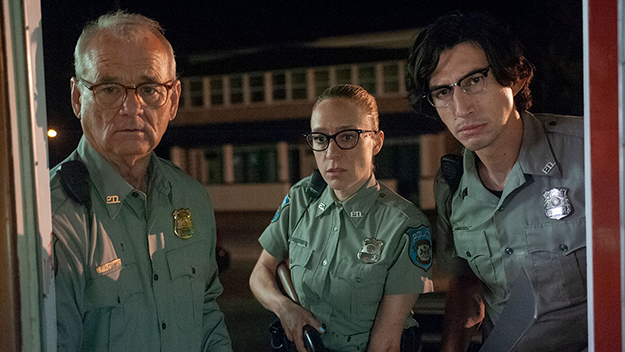Cannes Interview: Jim Jarmusch

All images from The Dead Don’t Die (Jim Jarmusch, 2019)
“I wanted to make something entertaining but with some bite,” Jim Jarmusch says of his zombie movie, The Dead Don’t Die, which opens the Cannes Film Festival today, and simultaneously on at least 500 screens in France. It arrives in the U.S. on June 14. Jarmusch tells me that he’s been working on it for over a year and is still too close to it to be able to say what it is, but that he feels that way about most of his movies. I think it’s one of his best—lively, funny, smart, beautiful, and very, very sad, because almost all of the characters are really nice people and almost all of them will be killed by similarly nice people who awoke (now there’s a contradictory term that I forgot to ask Jarmusch about) from their graves because they tacitly allowed something very bad to happen to the entire planet. These awakenings will continue in an endless cycle until everyone is zombified—truly, “The Dead Won’t Die.” The very bad thing that precipitates the zombie apocalypse in the film is fracking at the North Pole, a result of our collective desire for more and more stuff—i.e., remaining a society built on consumption, which is now chomping on its own entrails. The Dead Don’t Die stars Bill Murray, Adam Driver, Chloë Sevigny, Tilda Swinton, Steve Buscemi, Tom Waits, Danny Glover, Selena Gomez, Caleb Landry Jones, and more. The below Q&A is excerpted from an interview conducted in New York City on May 2.
Did you play zombies when you were a kid?
Not very often, and I’m not a fan of zombie movies. I like the classic things, but Romero is my postmodern zombie hero. Pre-Romero, zombies were people that were supposedly inferior, like Haitians, where you could control them and have them do your bidding. Or White Zombie was about a girl they zombified. But when Romero made Night of the Living Dead, he made what I call postmodern zombies. Monsters used to come from outside the social order—Frankenstein, Dracula, Godzilla—but Romero had zombies coming from inside a social order that was malignant. He was the first to show that inside, everything’s falling apart. So I love Night of the Living Dead, and Dawn of the Dead, and Day of the Dead. I like the Korean movie Train to Busan. That’s an extreme zombie movie, with thousands of zombies, and they move really fast. Those were some bad-ass zombies. But I’m a vampire guy. I like vampires. They’re sophisticated, shape-shifters, survivalists, and they are not really undead or reanimated. They’re just immortal by their situation.
So what made you want to make a zombie movie?
I don’t know. I don’t know why I decide to do anything. Just the inherent metaphorical potency of zombies, especially now. All the behavior of sheep. Romero, too, focuses on consumerism as a malignancy. It’s good metaphor, for sure, for now. They are kind of a modern mythology.
I don’t think of the zombies in your movie as coming from within or without.
They’re just ordinary schmoes.
But they’re coming into being because we’ve destroyed the planet.
And I believe that’s true of Romero’s zombies too. But even that cause of their reanimation is from within. It’s not like they are zombie aliens from outer space invading us. We really fucked it up. As Hermit Bob [Tom Waits] says at the end of my movie, “What a fucked-up world.”
Let’s talk a little about what you actually see on the screen.
I love the performances. I wrote for Tilda, Bill, Adam, Chloë, Steve. I like that the only people who are not killed, or don’t come back as zombies, are Hermit Bob, who has divorced himself from any social structure, and the teenagers who flee the detention center. And they are people who didn’t function in the real social order. Through history, teenagers have created the hallmarks of literature, art, style, music. My heart is always with teenagers.
Look out for more from Jim Jarmusch in Film Comment’s next issue, and hear more from Amy Taubin and our other guests on the daily Cannes edition of The Film Comment Podcast, covering The Dead Don’t Die and the rest of the films at the festival.
Amy Taubin is a contributing editor to Film Comment and Artforum.







